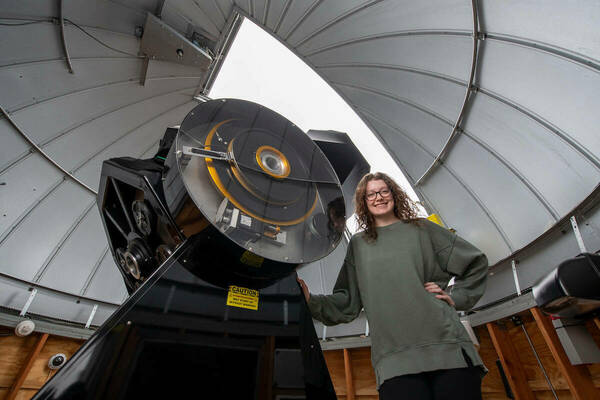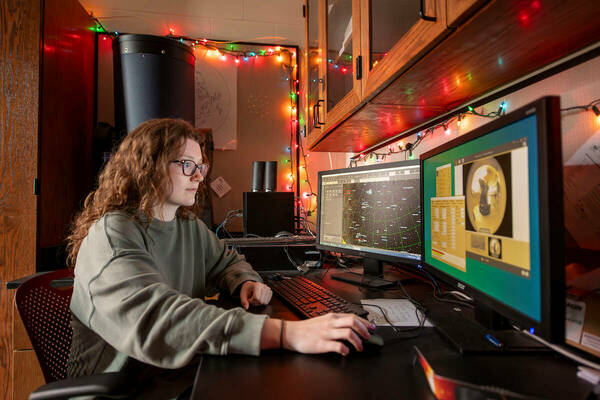
There is a very dark room attached to the roof of the Jordan Hall of Science. Inside, computers and viewing technology power the Sarah L. Krizmanich telescope, where McKenna Leichty has spent countless hours doing research, staying up until the early morning hours to track the stars.
That work paid off. This year, Leichty’s research revealed a new “Eccentric Planet” orbiting the binary star V808 Aurigae using data collected from that telescope.
Leichty is a senior studying physics with concentrations in astrophysics and advanced physics, researching under the guidance of Peter Garnavich, professor in the Department of Physics and Astronomy. A South Bend native, Leichty attended John Adams High School, where she was inspired by her teachers to pursue physics as a career.
“I have always loved seeing math applied to real life. We can explain our real-life observations with equations,” she said. “Even in astrophysics research, I am learning to understand real concepts. I like learning how things work.”
In her research with Garnavich, Leichty focuses on a specific type of binary star system known as cataclysmic variable stars (CVs). A CV contains a white dwarf and a companion star, orbiting a center of mass. The most recent system she looked at, called V808 Aur, is oriented to us in such a way that astronomers can see when the companion star eclipses the white dwarf.
The time it takes for the eclipse to happen is so regular that we can predict when the next eclipse will occur,” she said.
When the predictions don’t match their observations, astrophysicists then look for a cause, or perhaps an error in observation. Changes in data could be a result of something as small as a glitch in the computer clock or a calibration issue with the telescope. So, when Leichty found a deviation in her observations, it was time to ask those probing questions.

“We found a 50-second deviation in our timings for 2016 which came as a shock. We thought there was something wrong with the telescope!” said Leichty. But when they compared their timings with other collaborators, they knew this wasn’t a problem with the telescope. Leading an international collaboration of astrophysicists, Leichty combined the new Krizmanich data with observations going back to the discovery of the binary. She applied an equation that accounted for the gravitational tug of a planetary body in the system.
“The paper had an equation that fit our data really well, so well that I was almost in disbelief. We now believe there is a third body in the system — a planet!” shared Leichty.
The data implies that the planet has a very elliptical orbit, meaning that its gravitational kick is only seen for a short time when the planet passes close to the binary. “It is less massive than a brown dwarf, but seven times the mass of Jupiter, and an orbital period of about 11 years. Because the jump in timings happened in 2016, we predict that the next jump will happen in the next four years. But the record for confirming planets around similar star systems is poor. So for now we are saying it is a probable planet.”
With this exciting discovery, Leichty looks ahead to graduation, and further astrophysics research. She plans to get her doctorate in astrophysics at Michigan State University, and of course, continue staying involved in this project. Her goal, someday, is to work at NASA.
Originally published by at science.nd.edu on April 22, 2024.